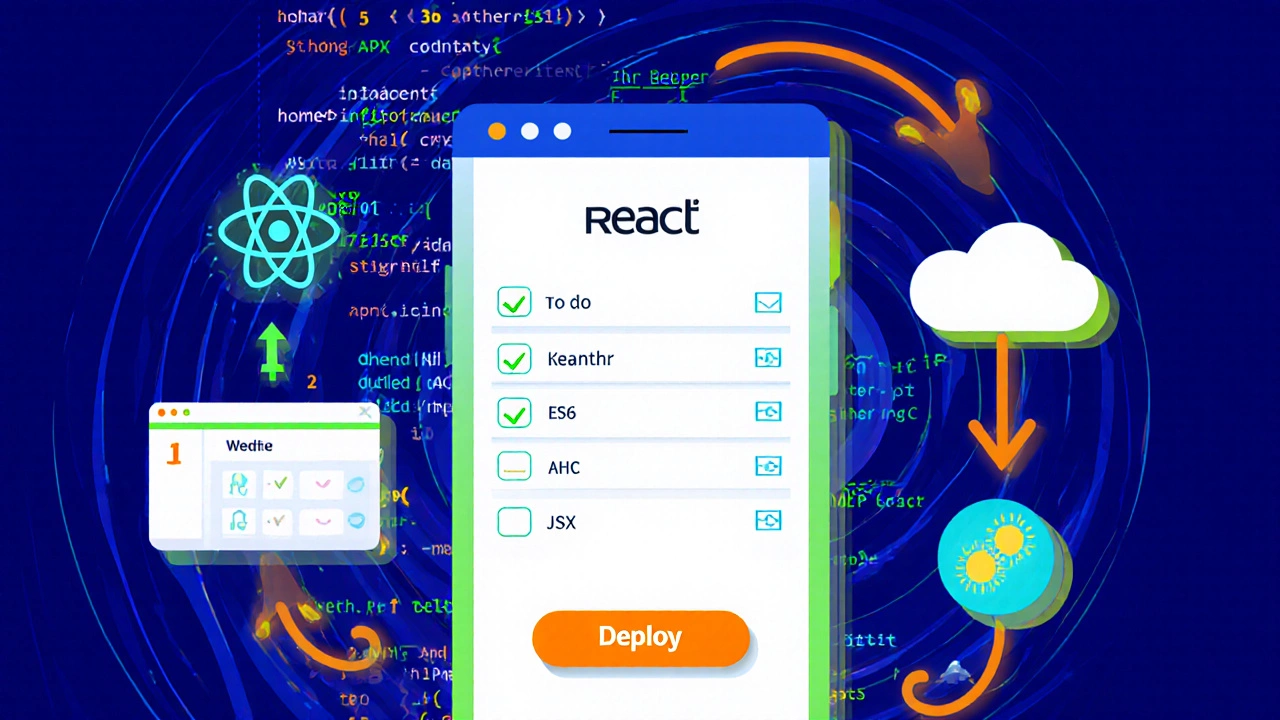3-Month Web Development Roadmap Planner
Month 1
Foundations
Month 2
JavaScript & Frontend Frameworks
Month 3
Backend & Portfolio
Skills Covered:
- HTML: Semantic elements, forms, accessibility
- CSS: Flexbox, Grid, Responsive Design
- Git: Version control with GitHub
Deliverable: Personal static site hosted on GitHub Pages
- MDN Web Docs
- freeCodeCamp HTML/CSS Course
- GitHub Setup Guide
Skills Covered:
- JavaScript: DOM manipulation, ES6+, Async/Await
- React: Components, Props, State, Hooks, Routing
Deliverable: Single-page application consuming public API
- JavaScript.info
- React Official Documentation
- React Router Tutorial
Skills Covered:
- Node.js: Express server setup
- SQL: CRUD operations, database connection
- Portfolio: Case studies, deployment
Deliverable: Full-stack application with React and Node.js
- Node.js Official Docs
- PostgreSQL Tutorial
- Netlify/Vercel Deployment Guides
Learning Tips
- Commit code daily to GitHub
- Build one project per month
- Join developer communities
- Aim for 2-3 focused hours daily
Your Learning Path Options
Self-Paced
Low cost ($0-$200), flexible schedule, community support
Bootcamp
Structured program, mentorship, job placement support
Degree
Comprehensive education, academic credentials
Wondering if you can become a functional web developer in just three months? The short answer is yes - if you follow a focused plan, use the right resources, and stay disciplined. Below is a practical roadmap that turns a total beginner into someone who can build real‑world sites, showcase a portfolio, and start hunting entry‑level jobs or freelance gigs.
Key Takeaways
- Master the core trio - HTML, CSS, and JavaScript - in the first six weeks.
- Add a front‑end framework (React) and basic back‑end (Node.js & SQL) in month two and three.
- Build a portfolio project each month to cement learning and impress recruiters.
- Choose one learning path - self‑paced, bootcamp, or degree - based on budget, time, and personal style.
- Keep Git for version control from day one; it’s non‑negotiable for any developer.
What Web development is
Web development is the process of building websites and web applications that run in browsers or on servers. It splits into two main sides: front‑end (what users see) and back‑end (the server, database, and logic). Understanding both gives you the flexibility to create full‑stack solutions or specialize in a niche.

Three‑Month Learning Blueprint
Think of the timeline as a sprint. Each month has a clear goal, a set of deliverables, and a handful of resources. Treat the schedule as a contract with yourself - stop procrastinating, and you’ll see tangible results.
Month1 - Foundations (HTML, CSS, and Git)
Start with the building blocks of every web page.
- HTML: HTML is the markup language that structures content on the web. Learn tags, semantic elements, forms, and accessibility basics.
- CSS: CSS is the styling language that controls layout, colors, and responsiveness. Master Flexbox, Grid, and a design system like Tailwind or Bootstrap.
- Git: Git is a version‑control system that tracks changes and enables collaboration. Create a GitHub account, learn commit, branch, merge, and push workflows.
Deliverable: a personal static site (about page, portfolio teaser, contact form) hosted on GitHub Pages.
Month2 - JavaScript and Front‑end Frameworks
JavaScript turns static pages into interactive experiences.
- JavaScript: JavaScript is the scripting language that runs in browsers, enabling dynamic UI and API calls. Cover variables, functions, DOM manipulation, ES6+ features, and async/await.
- React: React is a component‑based library for building user interfaces, maintained by Facebook. Learn components, props, state, hooks, and routing with React Router.
Deliverable: a single‑page app (e.g., a to‑do list or weather widget) that consumes a public API and uses React.
Month3 - Back‑end Basics, Databases, and Portfolio Polish
Now you’ll make your front‑end talk to a server.
- Node.js: Node.js is a JavaScript runtime that lets you run code on the server side. Set up an Express server, handle routes, and serve JSON.
- SQL: SQL is the language used to query relational databases like PostgreSQL or MySQL. Perform CRUD operations and connect the database to your Node API.
- Portfolio: Portfolio is a curated collection of projects that showcases your skills to employers or clients. Add the projects from months1‑3, write case studies, and deploy on Netlify or Vercel.
Deliverable: a full‑stack app (e.g., a simple blog or e‑commerce prototype) with front‑end React, back‑end Node/Express, and a PostgreSQL database.
Choosing the Right Learning Path
Not everyone learns the same way. Below is a quick visual guide comparing three popular routes.
| Aspect | Self‑Paced | Bootcamp | Degree (Accelerated) |
|---|---|---|---|
| Cost | $0‑$200 (free courses, Udemy, YouTube) | $4,000‑$12,000 | $15,000‑$30,000 |
| Time Commitment | Flexible, 15‑20 hrs/week | Full‑time, 40 hrs/week | Full‑time, 40 hrs/week + exams |
| Mentorship | Community forums, Discord | Dedicated instructors, career coaches | Professors, teaching assistants |
| Job Placement Support | None to limited | High (internships, hiring partners) | Campus recruitment, alumni network |
| Best For | Self‑motivation, low budget | Fast‑track, career switchers | Long‑term academic credentials |
Essential Tools & Skills Checklist
- Code editor - VSCode (extensions: Prettier, ESLint)
- Browser DevTools - Chrome/Firefox for debugging
- Version control - Git + GitHub
- Package manager - npm or yarn
- API testing - Postman or Insomnia
- Deployment - Netlify (front‑end), Render or Railway (back‑end)
- Responsive design - Mobile‑first media queries
Common Pitfalls & How to Dodge Them
Sticking to a three‑month plan is doable, but many learners hit roadblocks. Here’s how to stay on track:
- Trying to learn everything at once. Focus on the core stack (HTML, CSS, JavaScript) before adding frameworks.
- Skipping hands‑on projects. Every concept should be solidified by building a working feature.
- Neglecting version control. Commit daily; it saves you from lost code and shows professionalism.
- Ignoring community. Join a Discord server or Reddit community; peer feedback accelerates learning.
- Over‑optimizing for perfection. Ship a minimal viable product first, then iterate.
After You Finish the 3‑Month Sprint
Now that you have a portfolio and a solid foundation, consider your next move:
- Apply for junior developer roles. Highlight the three projects you built and the technologies used.
- Start freelancing. Platforms like Upwork or Fiverr let you pick small gigs to earn while you learn.
- Deepen specialization. Pick a path - React, Node, UI/UX, or DevOps - and invest another 2‑3 months mastering it.
- Contribute to open source. Fix bugs, add features, and get your name on real‑world codebases.
Remember, the three‑month milestone is just the start. Continuous practice and real‑world experience will turn you from a competent coder into a confident developer.
Frequently Asked Questions
Is three months enough to become a professional web developer?
Three months can give you a job‑ready skill set for junior positions if you follow a disciplined plan, build real projects, and keep learning after landing a role.
Do I need a computer science degree to get hired?
No. Many employers prioritize a solid portfolio and demonstrable skills over formal degrees, especially for entry‑level roles.
Which language should I learn first: HTML/CSS or JavaScript?
Start with HTML and CSS because they are the foundation of any web page. Once you can build static layouts, move to JavaScript for interactivity.
How much time should I spend coding each day?
Aim for 2‑3 focused hours daily. Consistency beats occasional marathon sessions, and it helps retain concepts.
What free resources can I use for the three‑month plan?
Free options include Mozilla Developer Network (MDN) for HTML/CSS/JS, freeCodeCamp, The Odin Project, and YouTube channels like Traversy Media and The Net Ninja.





